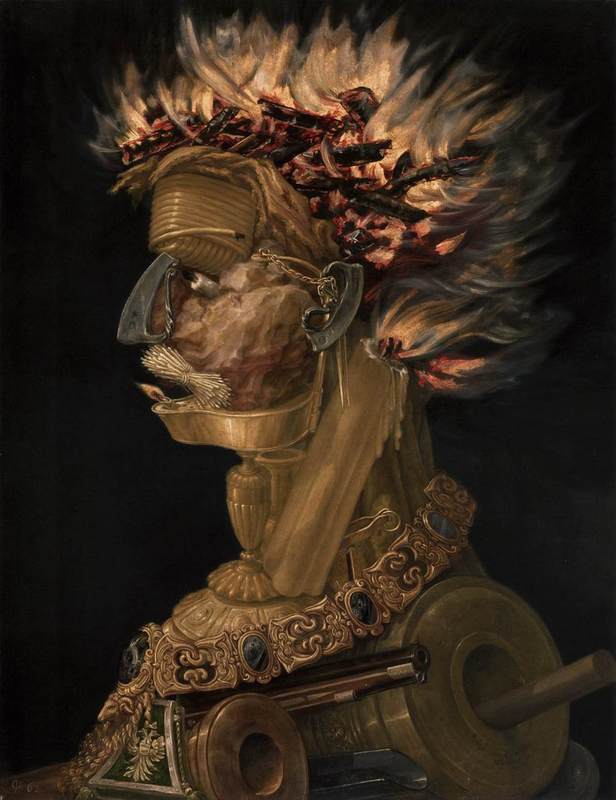Fire

Giuseppe Arcimboldo, "Fire," from Four Elements, 1566. Oil on wood, 67 x 51 cm, Kunsthistorisches Museum, Vienna. GG_1585
The composition of “Fire” is unique and presents a break from the method of arrangement Arcimboldo uses in the other three paintings of the series. Although certain animals (such as the salamander) were believed to have been bred from and lived within fire, instead Arcimboldo chooses to compose “Fire” from a variety of objects that can create the element. Through these objects, Arcimboldo manages to capture every kind of fire, ranging from the small and non-intimidating like the candle or oil lamp to the ferocious gun barrel or pure and all but out-of-control fire that radiates from the portrait’s head. This is allows "Fire" to become perhaps the most overtly praiseful painting in the series. In choosing to use man-made objects that can create the element, Arcimboldo emphasizes man's dominion over fire.
“Fire” also makes additional direct references to Arcimboldo’s patron and eventual recipient of the two series, Holy Roman Emperor Maximilian II of the Hapsburg dynasty. The figure wears the chain of the Order of the Golden Fleece, which was a prominent chivalric order in the Hapsburg Court (note 1). Beneath the chain sits the emblem of a double eagle, which is a symbol of the Holy Roman Empire that Maximillian II ruled. With the use of various weaponry to shape the body in addition to the heraldic symbols used, Arcimboldo suggests Maximilian II’s dominance over fire not only as an element, but also as a source of weaponry and as a tool of war. Maximilian II was a soldier prior to ascending the throne of Holy Roman Emperor, so the elevation of his person to a man who not only controls an empire but also weaponry and the element it harnesses is an important aspect of the painting. The fire bursting from the portrait’s head also “crowns” the figure much like the emperor himself is crowned as ruler. Also, it is within this painting that Arcimboldo’s signs for Four Seasons, in the bottom right corner on the barrel of the gun.
"Fire" is paired with "Summer" of the Four Seasons. The heat of summer is evident in "Fire's" flames, and their bright colors play off each other. Additionally, both paintings feature Arcimboldo's signature for the series, where "Summer's" signature is woven into her gown and "Fire's" is etched into the gun barrel on the opposite corner.
Notes
note 1. Pagden, Sylvia Ferino. Arcimboldo: 1526-1593. Milan: Skira, 2007. 148. Print. Also note that another reference to the Order of the Golden Fleece can be found in "Earth"